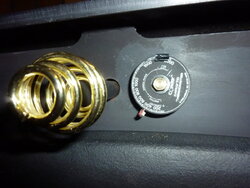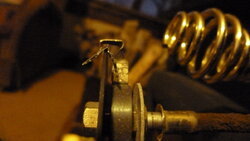On my second season with our buck 91. Using it as a freestanding stove. It works great except when the blower is off, you get super high cat temps. I'm concerned what the stove would do if the power goes out. Any thoughts?
Buck 91 overheating
- Thread starter mhkaiser
- Start date
-
Active since 1995, Hearth.com is THE place on the internet for free information and advice about wood stoves, pellet stoves and other energy saving equipment.
We strive to provide opinions, articles, discussions and history related to Hearth Products and in a more general sense, energy issues.
We promote the EFFICIENT, RESPONSIBLE, CLEAN and SAFE use of all fuels, whether renewable or fossil.
You are using an out of date browser. It may not display this or other websites correctly.
You should upgrade or use an alternative browser.
You should upgrade or use an alternative browser.
- Status
- Not open for further replies.
what temperatures are you seeing? What size chimney is it hooked to? How tall is it? Do you have a stack damper?
Heftiger
Feeling the Heat
Where is the cat temp gauge? If the fan is blowing over the gauge, you may be cooling the gauge and not the cat. My point being that the cat might be always that temp and you're getting false readings when the fan is on.
what temperatures are you seeing? What size chimney is it hooked to? How tall is it? Do you have a stack damper?[/QUOTE
It goes anywhere from 1700-2000 with the blower off. As soon as we turn the fan back on, instantly drops to a safe temp. It has an 8" flue connected to a 32 ft chimney on outside of house. We never had an issue of it not drafting. We don't have a stacked damper. Just really paranoid if we are at work and we lose power. With just a lil bit of wood in it, the temp is 800 with fan, 1600 without fan.
You are having problems with over drafting because of the height of your chimney. Put in a stack damper to slow it down.
Woody Stover
Minister of Fire
The air vents are off to the side of where the face of the cat thermo is, but the tip of the probe is inside anyway, and it does get hotter in that area when the blower is off. The breaker tripped a couple of times at my MIL's, and the cat temp went high once when this happened early in the load, when the cat was eatin'. You really need the blower to be running on this stove, but I've read here that others run their inserts with the blower off, so maybe some models are better able to shed heat without the blower on.Where is the cat temp gauge? If the fan is blowing over the gauge, you may be cooling the gauge and not the cat. My point being that the cat might be always that temp and you're getting false readings when the fan is on.
connected to a 32 ft chimney
Wow, yeah, my cat temp sometimes pushes 1500 with the blower on, and the stack is only 21' and draws pretty strong. That's with an insulated liner in an interior chimney though...You are having problems with over drafting because of the height of your chimney. Put in a stack damper to slow it down.
When we leave the house, we have the dampers set to where the cat runs at 1100-1200 because we are heating a 2800 sq. ft house. About a week ago, the fan shut off for some reason and the cat thermometer read 1900.
Woody Stover
Minister of Fire
Yeah mine did that inexplicably, as well. I already replaced the thermostat but it did it again. I have a new on/off/manual switch but I haven't put it in or run the stove yet this season. Other than those two items, I don't know what else it could be...blower? My stove is 7 yrs. old...I wouldn't think your blower would be worn at 2 yrs. (if you got the stove new.) I may email Buckstove and ask if they have any ideas. They have been helpful in the past.When we leave the house, we have the dampers set to where the cat runs at 1100-1200 because we are heating a 2800 sq. ft house. About a week ago, the fan shut off for some reason and the cat thermometer read 1900.
I am having a bit of a hard time figuring out what the blower running does to temp in the cat chamber. Stove top temp yes, but not in the cat. But I also was kinda shocked when I took a look and Buck said don't go over 40 feet with the chimney. A 30 foot chimney creates enough of a blast furnace. I cannot imagine what would happen with 40. And kinda don't want to know.
I can live with the blower issues, but any mechanical device will fail sooner or later. Not to mention unexpected power outage. I'm concerned that the blower will stop with a full load while I'm at work and I'll come home to a molten puddle of steel. So does this stove actually "need" the blower to be safe??
Totally agree. The reason that stove is taking off needs to be figured out. And there is no reason a stove should have to have the blower running to maintain a safe stove top temp. Have you given Buck a call? Apologies if the answer is somewhere in the thread.
put in a stack damper and see if it helps.When we leave the house, we have the dampers set to where the cat runs at 1100-1200 because we are heating a 2800 sq. ft house. About a week ago, the fan shut off for some reason and the cat thermometer read 1900.
Woody Stover
Minister of Fire
I don't think you will end up melting your stove, it is stoutly built. I haven't seen any damage to mine, and since I was usually loading the stove and then leaving, the fan may have been off or the cat temp may have gone high, at other times that I didn't know about. That said, I don't like to see the cat pushing 1800 on my stove, and I think it stays under control at this point in my learning curve. I rigged up a tin foil marker that tells me where the cat temp went while I was away.


The cat temp difference you're seeing seems high; I don't think mine varied by more than two or three hundred degrees between blower and no blower. If your wood isn't real dry, the stove may be getting to higher temps once the wood dries out and the load takes off, especially if you have strong draft. I would definitely install a pipe damper. So I have a few questions:


The cat temp difference you're seeing seems high; I don't think mine varied by more than two or three hundred degrees between blower and no blower. If your wood isn't real dry, the stove may be getting to higher temps once the wood dries out and the load takes off, especially if you have strong draft. I would definitely install a pipe damper. So I have a few questions:
- Where do you have the air set when you have a new load established, the bypass is closed, and the stove is cruising? I set mine with the left slider (shotgun or doghouse air) closed, and the right slider open maybe 1/8-1/4"....and that's on the 21' stack.
- How long has your wood been split and stacked in the wind? What varieties are you burning? What is the split size? Oak is notoriously slow-drying, but smaller split sizes of any dry wood will tend to off-gas faster and can lead to high cat/stove temps.
- Did you buy the stove new? If not, it may need some gasket work. My ash pan gasket developed a gap where the ends met, and I couldn't run the stove as low as I wanted until I addressed the ash pan, door and bay window gaskets. I always use OEM gaskets, and lightly silicone the ends of the ash pan gasket so they don't fray and develop a gap. You also have to install the ash pan gasket high enough along the top so that it seals well against the pan housing.
Last edited:
- Status
- Not open for further replies.
Similar threads
- Replies
- 20
- Views
- 2K
- Replies
- 6
- Views
- 597
- Replies
- 9
- Views
- 736
- Replies
- 9
- Views
- 872

